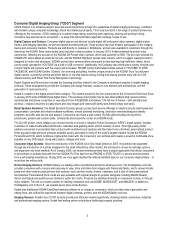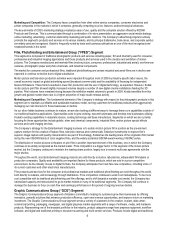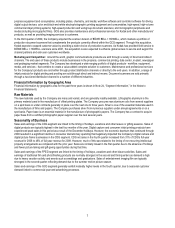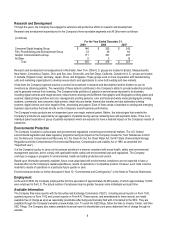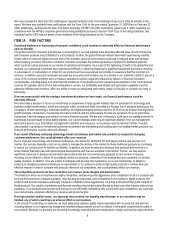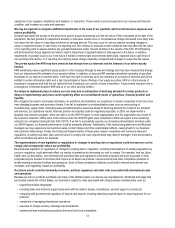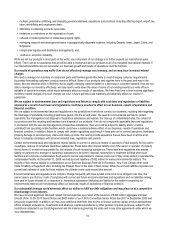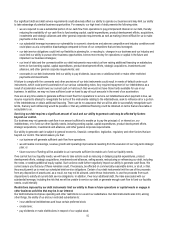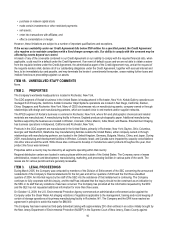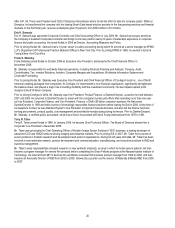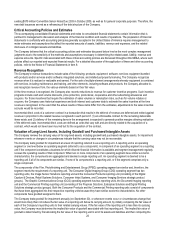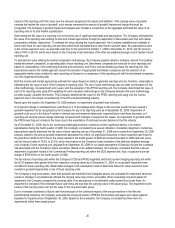Kodak 2009 Annual Report Download - page 17
Download and view the complete annual report
Please find page 17 of the 2009 Kodak annual report below. You can navigate through the pages in the report by either clicking on the pages listed below, or by using the keyword search tool below to find specific information within the annual report. 15
Our significant debt and debt service requirements could adversely affect our ability to operate our business and may limit our ability
to take advantage of potential business opportunities. For example, our high level of debt presents the following risks:
• we are required to use a substantial portion of our cash flow from operations to pay principal and interest on our debt, thereby
reducing the availability of our cash flow to fund working capital, capital expenditures, product development efforts, acquisitions,
investments and strategic alliances and other general corporate requirements as well as making it more difficult for us to make
payments on the notes;
• our substantial leverage increases our vulnerability to economic downturns and adverse competitive and industry conditions and
could place us at a competitive disadvantage compared to those of our competitors that are less leveraged;
• our debt service obligations could limit our flexibility in planning for, or reacting to, changes in our business and our industry and
could limit our ability to pursue other business opportunities, borrow more money for operations or capital in the future and
implement our business strategies;
• our level of debt and the covenants within our debt instruments may restrict us from raising additional financing on satisfactory
terms to fund working capital, capital expenditures, product development efforts, strategic acquisitions, investments and
alliances, and other general corporate requirements; and
• covenants in our debt instruments limit our ability to pay dividends, issue new or additional debt or make other restricted
payments and investments.
A failure to comply with the covenants and other provisions of our debt instruments could result in events of default under such
instruments, which could permit acceleration of our various outstanding notes. Any required repayment of our indebtedness as a
result of acceleration would lower our current cash on hand such that we would not have those funds available for use in our
business. In addition, we may not have sufficient cash on hand to pay all such amounts in the event of an acceleration.
If we are at any time unable to generate sufficient cash flow from operations to service our indebtedness when payment is due, we
may be required to attempt to renegotiate the terms of the instruments relating to the indebtedness, seek to refinance all or a portion
of the indebtedness or obtain additional financing. There can be no assurance that we will be able to successfully renegotiate such
terms, that any such refinancing would be possible or that any additional financing could be obtained on terms that are favorable or
acceptable to us.
Servicing our debt requires a significant amount of cash and our ability to generate cash may be affected by factors
beyond our control.
Our business may not generate cash flow in an amount sufficient to enable us to pay the principal of, or interest on, our
indebtedness, or to fund our other liquidity needs, including working capital, capital expenditures, product development efforts,
strategic acquisitions, investments and alliances, and other general corporate requirements.
Our ability to generate cash is subject to general economic, financial, competitive, legislative, regulatory and other factors that are
beyond our control. We cannot assure you that:
• our business will generate sufficient cash flow from operations;
• we will realize cost savings, revenue growth and operating improvements resulting from the execution of our long-term strategic
plan; or
• future sources of funding will be available to us in amounts sufficient to enable us to fund our liquidity needs.
If we cannot fund our liquidity needs, we will have to take actions such as reducing or delaying capital expenditures, product
development efforts, strategic acquisitions, investments and alliances, selling assets, restructuring or refinancing our debt, including
the notes, or seeking additional equity capital. Such actions could further negatively impact our ability to generate cash flows. We
cannot assure you that any of these remedies could, if necessary, be effected on commercially reasonable terms, or at all, or that
they would permit us to meet our scheduled debt service obligations. Certain of our debt instruments limit the use of the proceeds
from any disposition of assets and, as a result, we may not be allowed, under those instruments, to use the proceeds from such
dispositions to satisfy all current debt service obligations. In addition, if we incur additional debt, the risks associated with our
substantial leverage, including the risk that we will be unable to service our debt or generate enough cash flow to fund our liquidity
needs, could intensify.
Restrictions imposed by our debt instruments limit our ability to finance future operations or capital needs or engage in
other business activities that may be in our interest.
Our debt instruments impose operating and other restrictions on us and our subsidiaries. Our debt instruments also limit, among
other things, the ability of us and our restricted subsidiaries to:
• incur additional indebtedness and issue certain preferred stock;
• create liens;
• pay dividends or make distributions in respect of our capital stock;


